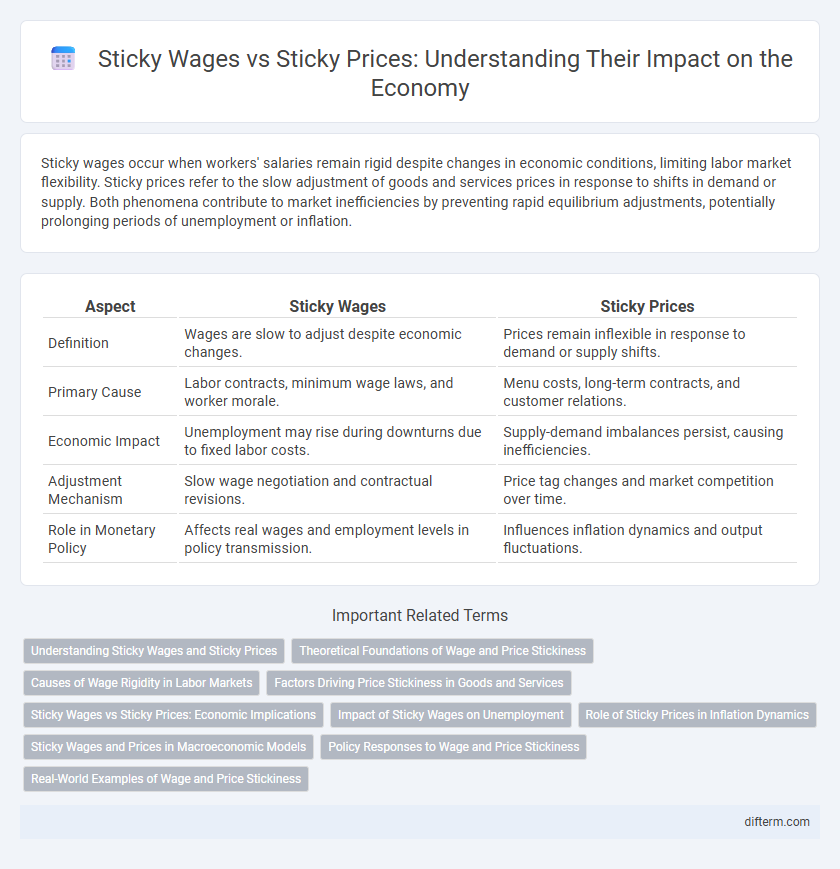Sticky wages occur when workers' salaries remain rigid despite changes in economic conditions, limiting labor market flexibility. Sticky prices refer to the slow adjustment of goods and services prices in response to shifts in demand or supply. Both phenomena contribute to market inefficiencies by preventing rapid equilibrium adjustments, potentially prolonging periods of unemployment or inflation.
Table of Comparison
| Aspect | Sticky Wages | Sticky Prices |
|---|---|---|
| Definition | Wages are slow to adjust despite economic changes. | Prices remain inflexible in response to demand or supply shifts. |
| Primary Cause | Labor contracts, minimum wage laws, and worker morale. | Menu costs, long-term contracts, and customer relations. |
| Economic Impact | Unemployment may rise during downturns due to fixed labor costs. | Supply-demand imbalances persist, causing inefficiencies. |
| Adjustment Mechanism | Slow wage negotiation and contractual revisions. | Price tag changes and market competition over time. |
| Role in Monetary Policy | Affects real wages and employment levels in policy transmission. | Influences inflation dynamics and output fluctuations. |
Understanding Sticky Wages and Sticky Prices
Sticky wages refer to the resistance of nominal wages to adjust quickly in response to economic changes, often due to long-term labor contracts or worker morale concerns. Sticky prices describe the slow adjustment of prices by firms, influenced by menu costs, customer relationships, and strategic pricing decisions. Both phenomena contribute to short-term economic rigidity, affecting inflation dynamics and output fluctuations.
Theoretical Foundations of Wage and Price Stickiness
Sticky wages arise from labor contracts, efficiency wages, and wage bargaining, preventing immediate adjustments to changes in labor market conditions. Price stickiness is grounded in menu costs, long-term supplier contracts, and customer relations that inhibit swift price changes despite shifts in demand or supply. Theoretical models like the New Keynesian framework incorporate both wage and price rigidity to explain persistent unemployment and output fluctuations in response to economic shocks.
Causes of Wage Rigidity in Labor Markets
Wage rigidity in labor markets often stems from long-term contracts, minimum wage laws, and union negotiations that prevent wages from adjusting quickly to economic fluctuations. Social norms and worker morale also contribute to sticky wages, as employers avoid wage cuts to maintain productivity and reduce turnover. These factors cause wages to be less flexible compared to prices, leading to persistent labor market inefficiencies.
Factors Driving Price Stickiness in Goods and Services
Price stickiness in goods and services predominantly stems from menu costs, where businesses face significant expenses in changing prices frequently. Long-term contracts and customer expectations also contribute by discouraging firms from adjusting prices rapidly, maintaining market stability. Furthermore, imperfect information and coordination problems prevent synchronized price changes across the economy, reinforcing rigidity in pricing.
Sticky Wages vs Sticky Prices: Economic Implications
Sticky wages hinder labor market adjustments during economic fluctuations, causing unemployment to persist despite changing demand. Sticky prices delay firms' ability to respond to shifts in production costs or demand, leading to inefficiencies in resource allocation. Understanding the differential impacts of sticky wages and sticky prices is crucial for designing effective monetary and fiscal policies to stabilize the economy.
Impact of Sticky Wages on Unemployment
Sticky wages occur when nominal wages are slow to adjust downward in response to economic downturns, leading to higher real wages than the market-clearing level. This wage rigidity prevents firms from reducing labor costs, causing them to lay off workers and resulting in increased unemployment. Empirical studies in macroeconomics highlight that sticky wages contribute significantly to persistent unemployment during recessions by hindering labor market flexibility.
Role of Sticky Prices in Inflation Dynamics
Sticky prices hinder immediate adjustments in response to demand or supply shocks, causing inflation to persist despite changes in economic conditions. Firms may keep prices fixed due to menu costs or long-term contracts, resulting in gradual price level shifts rather than instantaneous corrections. This price rigidity amplifies inflation inertia, complicating monetary policy efforts to stabilize the economy.
Sticky Wages and Prices in Macroeconomic Models
Sticky wages refer to the resistance of nominal wages to adjust quickly in response to economic fluctuations, causing labor market rigidities that can lead to unemployment or output gaps. Sticky prices occur when firms delay adjusting product prices despite changes in demand or supply due to menu costs or contract structures, contributing to price rigidity in the economy. Macroeconomic models incorporate sticky wages and prices to explain short-run non-neutrality of money, persistent unemployment, and the slow adjustment towards equilibrium after economic shocks.
Policy Responses to Wage and Price Stickiness
Policy responses to wage and price stickiness involve targeted monetary and fiscal measures to enhance market flexibility and reduce rigidities. Central banks may implement inflation targeting and adjust interest rates to influence nominal wages and prices, promoting quicker adjustments in labor and product markets. Fiscal policies such as wage subsidies or price controls can temporarily alleviate the adverse effects of stickiness, supporting employment and consumption during economic shocks.
Real-World Examples of Wage and Price Stickiness
In the real world, sticky wages are evident in long-term labor contracts and minimum wage regulations that prevent rapid wage adjustments despite economic fluctuations. Price stickiness is often observed in retail sectors where menu costs and customer expectations inhibit frequent price changes. Both phenomena contribute to economic rigidity, influencing inflation dynamics and unemployment rates during demand shocks.
Sticky Wages vs Sticky Prices Infographic

 difterm.com
difterm.com